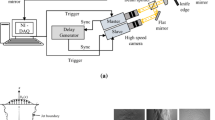Abstract
A high-speed and initial helium jet flow has been analyzed by a developed four-dimensional digital speckle tomography. Multiple high-speed cameras have been used to capture movements of speckles in multiple angles of view simultaneously because a shape of a nozzle for the jet flow is asymmetric and the initial jet flow is fast and unsteady. The speckle movements between no flow and helium jet flow from the asymmetric nozzle controlled by a solenoid valve have been obtained by a cross-correlation tracking method so that those distances can be transferred to deflection angles of laser rays for density gradients. The four-dimensional density fields for the high-speed helium jet flow have been reconstructed from the deflection angles by a developed real-time tomography method.









Similar content being viewed by others
Abbreviations
- b :
-
Basis function
- C :
-
Multiplicative correction vector
- f :
-
Actual field
- \(\ifmmode\expandafter\hat\else\expandafter\^\fi{f} \) :
-
Guessed or intermediate objective function to be optimized
- \(\ifmmode\expandafter\bar\else\expandafter\=\fi{f} \) :
-
Average value of phantom field f
- G :
-
Gladstone–Dale constant
- J :
-
Equally spaced points in x direction
- K :
-
Equally spaced points in y direction
- L :
-
Equally spaced points in z direction
- n :
-
Index of refraction
- n air :
-
Refractive index of ambient air
- n helium :
-
Refractive index of pure helium
- l :
-
Distance between the test section and the viewing screen
- O j :
-
Height coefficient of j-th basis function
- q :
-
Iteration number
- s :
-
Coordinate on the projection plane, perpendicular to the ray direction
- t :
-
Coordinate parallel to the ray direction
- W :
-
Projection matrix
- W i,j :
-
Weighting factor of MART
- w i :
-
i-th Row of projection matrix
- (x, y, z):
-
Objective field coordinate
- α :
-
Line-of-sight beam deflection angle
- δ :
-
Speckle displacement
- Φ :
-
Reconstruction error
- λ :
-
Laser wave length
- θ :
-
Angle of projection
- ρ :
-
Density
- ρ*:
-
Relative density
- ρ air :
-
Ambient air density
- ρ h :
-
Partial density of helium in mixture
- ρ helium :
-
Pure helium density
- \( \ifmmode\expandafter\hat\else\expandafter\^\fi{\psi } \) :
-
Virtual projection of guessed field
- ψ IF :
-
Interferometric projection of actual field
- ψ SP :
-
Digital speckle projection of actual field
References
Fomin NA (1998) Speckle photography for fluid mechanics measurements. Springer, Berlin Heidelberg New York
Françon M (1979) Laser speckle and applications in optics. Academic, New York
Gordon R (1974) A tutorial on ART. IEEE Trans Nuclear Sci NS-21:78–92
Hanson KM, Wecksung GW (1985) Local basis function approach to computed tomography. Appl Opt 24:4028–4039
Kihm KD, Kim JH, Fletcher LS (1993) Investigation of natural convection heat transfer in converging channel flows using a specklegram technique. J Heat Transfer 115:140–148
Ko HS, Kihm KD (1999) An extended algebraic reconstruction technique (ART) for density-gradient projections: laser speckle photographic tomography. Exp Fluids 27:542–550
Ko HS, Kim Y-J (2002) Comparison and analysis of tomography methods for reconstruction of three-dimensional density distributions in two-phase flows. J Nondestruct Test 22:545–556
Ko HS, Kim Y-J (2003) Tomographic reconstruction of two-phase flows. KSME Int J 17:571–580
Liu TC, Merzkirch W, Oberste-Lehn K (1989) Optical tomography applied to a speckle photographic measurement of asymmetric flows with variable density. Exp Fluids 7:157–163
Partington JR (1953) Physico-chemical optics, vol IV. An advanced treatise on physical chemistry. Longmans Green, London
Raffel M, Willert CE, Kompenhans J (1998) Particle image velocimetry. Springer, Berlin Heidelberg New York
Verhoeven D (1993) Limited-data computed tomography algorithms for the physical sciences. Appl Opt 32:3736–3754
Acknowledgements
This work was performed at Nuclear Engineering Research Laboratory of the University of Tokyo. This work was also partially supported by the Korea Research Foundation Grant funded by the Korean Government (No. R08-2003-000-10030-0).
Author information
Authors and Affiliations
Corresponding author
Rights and permissions
About this article
Cite this article
Ko, H.S., Ikeda, K., Ishikawa, M. et al. Experimental analysis of high-speed helium jet flow using four-dimensional digital speckle tomography. Exp Fluids 40, 442–451 (2006). https://doi.org/10.1007/s00348-005-0083-8
Received:
Revised:
Accepted:
Published:
Issue Date:
DOI: https://doi.org/10.1007/s00348-005-0083-8



